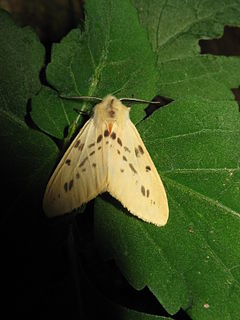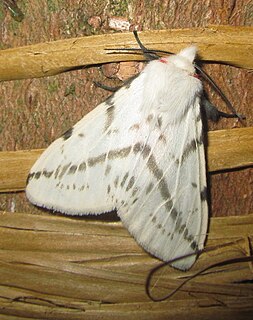
Lemyra is a genus of tiger moths in the family Erebidae. The genus contains many species from East and South Asia, Sundaland and Australia. It was described by Francis Walker in 1856.
Lemyra maculifascia is a moth of the family Erebidae. It was described by Francis Walker in 1855. It is found in China, Indonesia, Timor, the Philippines, New Guinea and Australia. It is found in secondary habitats, including bush, clearings in primary forests and plantations, from the sea level up to elevations of about 1,200 meters.
Lemyra boghaika is a moth of the family Erebidae. It was described by Yuri A. Tshistjakov and Yasunori Kishida in 1994. It is found in the Russian Far East and Korea. It is probably also present in China.
Lemyra costimacula is a moth of the family Erebidae. It was described by John Henry Leech in 1899. It is found in China.
Lemyra flammeola is a moth of the family Erebidae. It was described by Frederic Moore in 1877. It is found in China.
Lemyra flavalis is a moth of the family Erebidae. It was described by Frederic Moore in 1865. It is found in China, Nepal, India, Bhutan and Myanmar.
Lemyra heringi is a moth of the family Erebidae. It was described by Franz Daniel in 1943. It is found in Yunnan, China.
Lemyra hyalina is a moth of the family Erebidae. It was described by Cheng-Lai Fang in 1990. It is found in China in Guangxi and Guangdong.

Lemyra imparilis is a moth of the family Erebidae. It was described by Arthur Gardiner Butler in 1877. It is found in China, Taiwan, Japan and Korea.
Lemyra melanosoma is a moth of the family Erebidae. It was described by George Hampson in 1894. It is found in China, Pakistan, eastern India, Myanmar and Thailand.

Lemyra moltrechti is a moth of the family Erebidae. It was described by Miyake in 1909. It is found in Taiwan.

Lemyra multivittata is a moth of the family Erebidae. It was described by Frederic Moore in 1865. It is found in Nepal, India, Myanmar and China.
Lemyra nigricosta is a moth of the family Erebidae. It was described by Thomas in 1990. It is found in Taiwan.
Lemyra rhodophila is a moth of the family Erebidae. It was described by Francis Walker in 1864. It is found in China (Tibet), Pakistan, India, Myanmar and Nepal.
Lemyra rubidorsa is a moth of the family Erebidae. It was described by Frederic Moore in 1865. It is found in Pakistan (Kashmir), India and China.
Lemyra rubrocollaris is a moth of the family Erebidae. It was described by Reich in 1937. It is found in China (Jiangsu).
Lemyra sikkimensis is a moth of the family Erebidae. It was described by Frederic Moore in 1879. It is found in India and China.
Lemyra spilosomata is a moth of the family Erebidae. It was described by Francis Walker in 1865. It is found in southern India.

Lemyra stigmata is a moth of the family Erebidae. It was described by Frederic Moore in 1865. It is found in China, Pakistan, India, Nepal, Bhutan, Myanmar, Thailand and Vietnam.
Lemyra subfascia is a moth of the family Erebidae. It was described by Francis Walker in 1855. It is found in Sri Lanka.




